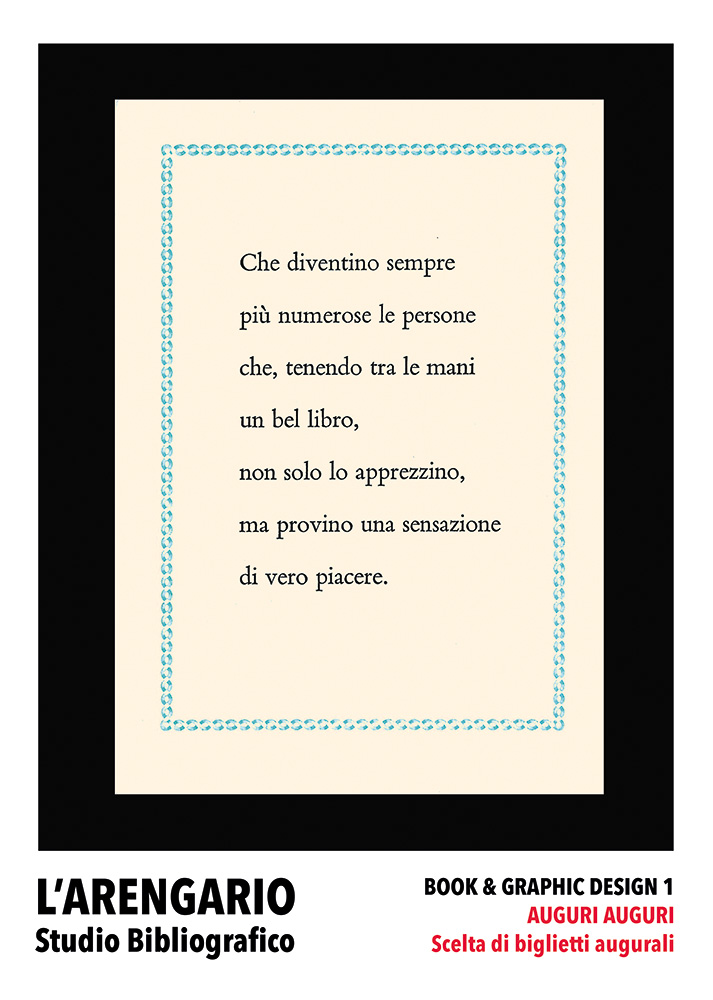L'ARENGARIO STUDIO BIBLIOGRAFICO - Dott. Paolo Tonini
Auguri auguri. Scelta di biglietti augurali
Luogo: Gussago
Editore: L'Arengario Studio Bibliografico, "Graphic & Book Design 1"
Stampatore: prodotto in proprio
Anno: 2023 (24 gennaio)
Legatura: brossura
Dimensioni: 29,7x21 cm.
Pagine: pp. VIII - 173 (3) compresa la copertina
Descrizione: copertina con la riproduzione a colori di un biglietto augurale. Catalogo interamente illustrato a colori, 173 schede ragionate con i prezzi. A cura e con testo introduttivo di Paolo Tonini («Auguri auguri»). Edizione in formato digitale.
Bibliografia: N. D.
Prezzo: N. D.ORDINA / ORDER
La tradizione dei biglietti augurali sembra risalire al XV secolo, messaggi per lo più goliardici che gli studenti si scambiavano in occasione dell’ultimo giorno dell’anno, ma il biglietto augurale come lo conosciamo è un prodotto dell’epoca vittoriana: a partire da quell’epoca il messagio vero e proprio, quello che dovrebbe trasmettere il sentimento dell’augurio, viene affidato all’immagine. Abbiamo raccolto biglietti augurali significativi del Novecento: attraverso le immagini si percepisce una evoluzione che partendo dalla figurazione arriva gradatamente a una eleganza minimale ben rappresentata nel terzo millennio, per esempio, dalle immagini diafane di Michael Lin per Pomellato o dai biglietti “tipografici” dove protagonisti sono i caratteri, non più vincolati al linguaggio. Infine siamo tornati alla scrittura, ma senza l’affetto o l’ironia, senza speranza né illusione, depurata da ogni sentimento, da ogni coinvolgimento con la vita corrente, da ogni messaggio. Una eleganza che affascina e non lascia scampo.
- - - -
The tradition of greeting cards seems to date back to the fifteenth century, mostly goliardic messages that students exchanged on the last day of the year, but the greeting card that we know is a product of the Victorian era: from that time on, the actual message, the one that should convey the feeling of the wish, was entrusted to the image. We have collected significant greeting cards from the twentieth century: through the images, one perceives an evolution which starting from the figuration gradually arrives at a minimal elegance well represented in the third millennium, for example, by the diaphanous images of Michael Lin for Pomellato or by the “typographic” tickets, where the characters are protagonists, no longer bound to the language. Finally we returned to writing, but without affection or irony, without hope or illusion, purified of every feeling, of every involvement with current life, of every message. An elegance that fascinates and leaves no way out.
DOWNLOAD PDF FILE
- - - -
The tradition of greeting cards seems to date back to the fifteenth century, mostly goliardic messages that students exchanged on the last day of the year, but the greeting card that we know is a product of the Victorian era: from that time on, the actual message, the one that should convey the feeling of the wish, was entrusted to the image. We have collected significant greeting cards from the twentieth century: through the images, one perceives an evolution which starting from the figuration gradually arrives at a minimal elegance well represented in the third millennium, for example, by the diaphanous images of Michael Lin for Pomellato or by the “typographic” tickets, where the characters are protagonists, no longer bound to the language. Finally we returned to writing, but without affection or irony, without hope or illusion, purified of every feeling, of every involvement with current life, of every message. An elegance that fascinates and leaves no way out.
DOWNLOAD PDF FILE

